The family road trip has made a comeback and with it, families are looking for even more road trip ideas. While plenty of East Coasters have made the road trip down 95 to Florida over the years, now families want to take time to stop and explore along the way. With so much to see, we have divided this part of the country up into 20 different East Coast road trips, each of which could be done in a one-week vacation.
Each of these mini East Coast road trip itineraries will give you ideas for new ways to explore sections of the East Coast of the U.S.A. Check off one at a time or string a few together for a longer vacation.
Not sure where to start? Here are my top picks:
- Best for nature fans: White & Green Mountains in NH and VT
- Best for history buffs: Colonial History Philadelphia to Williamsburg
- Best for beach lovers: Coastal Islands: Wilmington NC to Jacksonville FL
- Best for national park stampers: Blue Ridge Mountains
- Best for theme park fans: Daytona to Tampa
- Best iconic views: Florida Keys road trip
20 East Coast Road Trips
Each of these East Coast road trip ideas should take approximately 7 to 10 days to complete as outlined. My goal is to only require one week of vacation time from work, since that is the typical family vacation. I’ve linked to some more detailed road trip itineraries and included maps to give you an overview of the route.
Note: This post may contain affiliate links. If you click a link and make a purchase, I may receive a small commission. All opinions are my own.
New England Coast: Boston to Bar Harbor, ME

The drive from Boston, Massachusetts up to Bar Harbor, Maine can be done in about four hours on the highway, but it is better to take the scenic route and explore Vacationland’s scenic coast along the way. One of the best East Coast road trips, this one is full of Maine foods like lobster rolls, blueberry soda, and whoopie pies; as well as lighthouses, rocky coasts, quaint small towns, and Acadia National Park.
Portland: spend 2 nights in Portland exploring the Old Port, maybe taking a lobster boat tour, climbing on the rocks by Portland Head Light in Cape Elizabeth, or spending a day shopping at the L.L. Bean outlet up in Freeport. You could also visit some local breweries or take a day trip to Maine Wildlife Park in Gray to see some moose.
Where to stay: The Press Hotel, Inn by the Sea, or the Courtyard Marriott Waterfront
Boothbay Harbor: spend 1-2 nights in Boothbay Harbor. On your way, stop and enjoy the coastal towns, Giant’s Stairs in Harpswell, spend an afternoon soaking up the sun on Popham Beach, a rare sandy stretch of sand, and be sure to line up for lobster rolls at Red Eats.
The next day, get out on the water with one of Boothbay Harbor’s many sightseeing cruises to see puffins or whales, or rent a sea kayak to explore Muscongus Bay. Leave time to browse at the many boutiques in town.
Where to stay: Tugboat Inn, Fisherman’s Wharf Inn
Rockland: spend 1 night enjoying the artistic town of Rockland. Pop into the Center for Maine Contemporary Art or the Farnsworth Art Museum. If the outdoors holds more appeal, hop aboard a traditional Maine Windjammer for a short sail, walk along the Rockland Breakwater, or explore the trails at Camden Hills State Park. This arts city of Maine is such a delightful surprise!
Where to stay: 250 Main Hotel
Bar Harbor: finish up your road trip at the scenic town of Bar Harbor, just outside of Acadia National Park. You will want to spend 2 to 3 nights exploring the park. Try to catch a sunrise or sunset from the top of Cadillac Mountain, drive the Park Loop Road, relax on Sand Beach, stop to see the natural phenomenon at Thunder Hole, take in the view from Otter Cliffs, bike the Carriage Roads, and check out some of the popular hikes. Don’t forget to enjoy an authentic lobster pound before you take the fast route back to Portland. (See more things to do near Acadia National Park.)
Where to stay: Bar Harbor Grand Hotel, Hampton by Hilton Bar Harbor, or go glamping at the Terramor Outdoor Resort
Read more: Check out my full coastal Maine road trip itinerary
White & Green Mountains: Boston, MA to Burlington, VT
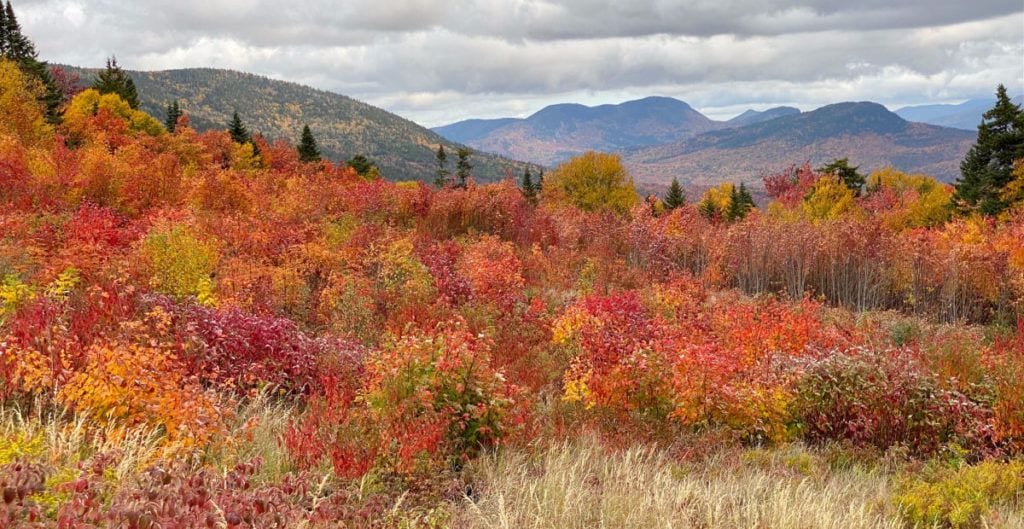
The drive from Boston to Burlington takes only about 4 hours, but use this New England road trip to spend time enjoying the beautiful scenery of the White Mountains of New Hampshire and the Green Mountains of Vermont along the way, especially during fall foliage season.
Boston: if you haven’t been to Boston, plan on spending 2 nights enjoying this historic city. Don’t miss the Boston Tea Party Ships and Museum, walk the Freedom Trail, enjoy a swan boat tour in Boston’s Public Garden, and taste your way through Boston’s Little Italy in the North End.
Where to stay: Fairmont Copley Plaza, Boston Harbor Hotel
Lincoln, NH: Lincoln can make a nice home base for 1-2 nights of exploring the White Mountains. Hike through the Flume Gorge, zip line, or hike at Loon Mountain, ride the Mount Washington Cog Railway, or drive the Mount Washington Auto Road. There are also plenty of hikes to try, rock climbing, a scenic drive on the Kancamagus Highway, and splashing in the waterfalls at Diana’s Baths.
Where to stay: Riverwalk Resort at Loon Mountain, Lumen Nature Retreat, Alpine Garden Glamping, or Huttopia
Stowe, VT: spend a couple of nights enjoying the Green Mountains from a home base in Stowe. On your drive from New Hampshire, you may want to stop at the Cabot cheese factory, Ben & Jerry’s Factory, and the Cold Hollow Cider Mill. In Stowe, you can enjoy hiking, mountain biking, and other resort activities.
Where to stay: TopNotch Resort, Stowe Mountain Resort
Burlington, VT: Finish your road trip with a night in the hip waterfront city of Burlington. There are so many things to do in Burlington, VT and you can check out nearby Shelburne Farm, and the ECHO museum. Or if you prefer lake life, finish with a few days on Lake Champlain at the Basin Harbor Hotel.
On your drive back to Boston, be sure to stop and stroll through the charming downtown of Woodstock.
Where to stay: Hotel Vermont, Courtyard Burlington Harbor
Read more: Vermont Route 100 road trip stops, things to do in the White Mountains
Southern New England COast: New York, NY to Provincetown, MA
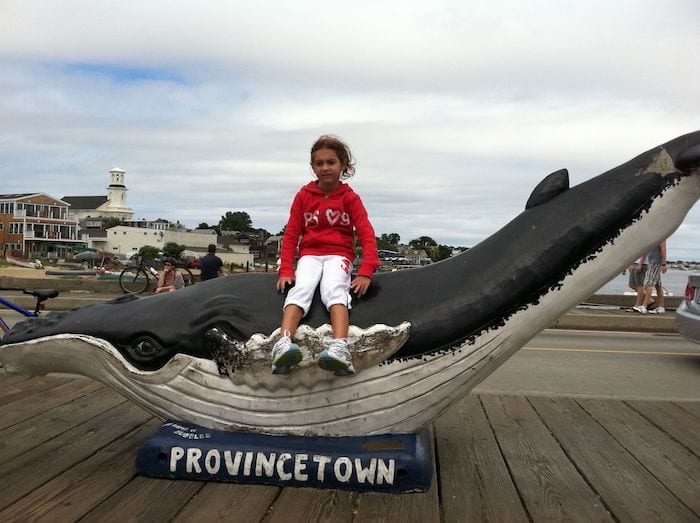
You should be able to make the trip from New York to Provincetown at the tip of Cape Cod in 5 to 6 hours, but the traffic can be horrendous on summer weekends so try to travel midweek for this east coast road trip if you can.
Mystic, CT: Break up the trip with a night in Mystic. You will want to visit the historic Mystic Seaport, stroll through downtown, and maybe stop in at the Mystic Aquarium. You will find plenty of things to do in Mystic with kids.
Where to stay: Mystic KOA, Inn at Mystic
Newport, RI: spend a night in the yachting capital of the world. You can walk the Cliff Walk, fly a kite at Brenton Point State Park, visit some of the Newport Mansions, shop along Thames, and take a sail in the harbor.
Where to stay: Newport Marriott, The Vanderbilt
Providence, RI: instead of skipping over Rhode Island’s Creative Capital, spend a night to discover this little gem. Take a Rhode Island food tour, visit the RISD Museum, take a gondola or river boat ride, bike along the East Bay bike path, and, if you are lucky, take in Providence’s famous Waterfire.
Where to stay: The Graduate Providence, Aloft Providence Downtown
Falmouth, MA: stay the next 2 nights on the elbow of Cape Cod in Falmouth. Take time to relax on the beach and then hop the ferry over to Martha’s Vineyard or Nantucket for a day. You can also ride the Cape Cod bike trail or visit the Woods Hole Science Aquarium.
Where to stay: Sea Crest Beach Hotel or Autocamp Cape Cod
Provincetown, MA: finish your road trip with a couple of nights in the unique and vibrant town of Provincetown. You can shop, dine, take a tour of the sand dunes, go on a whale-watching tour, climb the lighthouse, or visit the Pirate Museum. The best part is searching the tide pools at low tide and watching the sunset.
Where to stay: Surfside Hotel & Suites
Read more: New York to Boston road trip itinerary, things to do in Providence
New York to Niagara Falls, NY
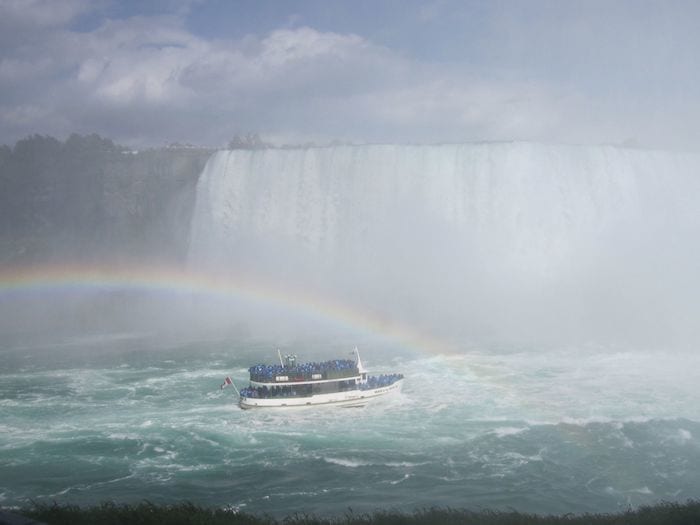
The drive from New York City to Niagara Falls can take 6 to 7 hours, but turn it into a road trip with a few days in the Finger Lakes region on the way and plenty of stops along the Western New York Upstate Eats Trail.
Watkins Glen: spend 2 nights in Watkins Glen, at the southern point of Seneca Lake. For fans of The Office, you may want to stop in Scranton, PA on your way for a self-driving tour of filming spots. Enjoy time on the lake, hike to the waterfalls in Watkins Glen State Park, or take a glider ride in Elmira, the Soaring Capital of the World.
Where to stay: Watkins Glen Harbor Hotel
Hammondsport: move over to Keuka Lake and spend a couple of nights in Hammondsport. You can enjoy water sports, wine tasting, and a day at the fascinating Corning Museum of Glass.
Where to stay: Keuka Lakeside Inn
Niagara Falls: you will want to spend 2 to 3 nights in Niagara to explore all the attractions including the Cave of the Winds, Maid of the Mist, Old Fort Niagara, jet boat tours, and hiking trails in Niagara Falls State Park.
Where to stay: Sheraton Niagara Falls, Hyatt Place Niagara Falls
Buffalo: on your return to New York, stop in for some food, history, and fun in Buffalo. This city is going through a renaissance and plenty of fun activities along the waterfront (in summer or winter). Make sure you try some of these must-eat foods in Buffalo too!
Where to stay: Buffalo Marriott LECOM Harborcenter
Cooperstown: on your return trip, be sure to stop in Seneca Falls and visit the Women’s Rights National Historical Park and the National Women’s Hall of Fame. Then spend a night in Cooperstown and visit the National Baseball Hall of Fame.
Where to stay: Otesaga Resort, Inn at Cooperstown
Read more: Things to do in Hammondsport, NY, New York road trips
PA Pitstops: Philadelphia to Pittsburgh, PA
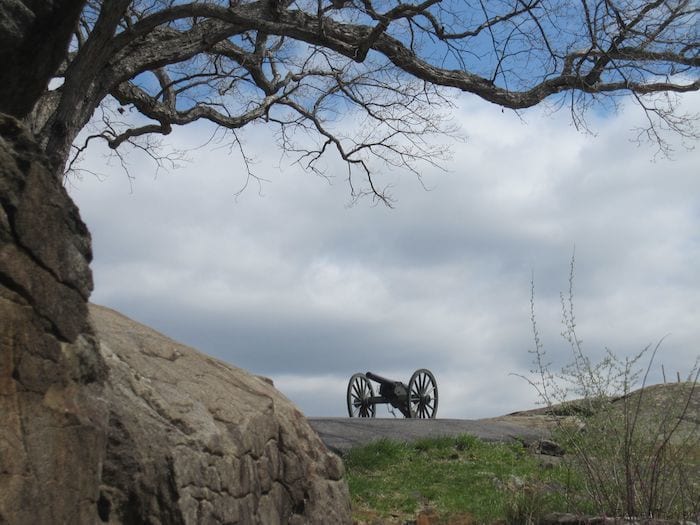
Driving from Philadelphia to Pittsburgh takes about five hours, but going straight through means you will miss out on some many historic, scenic, and family-fun spots along the way.
Lancaster: start your trip with a night in Lancaster’s Pennsylvania Dutch Country. You will want to take a buggy ride, indulge at an Amish feast, or take in some of the historic sites. You can also take a tour of the Turkey Hill Ice Cream Experience.
Where to stay: Residence Inn by Marriott Lancaster
Hershey: next stop is the sweetest place on earth, Hershey. You can spend the day at Hersheypark, visit Hershey’s Chocolate World, or the Hershey Experience. History buffs will enjoy the National Civil War Museum in Harrisburg, a good introduction before you head to Gettysburg.
Where to stay: Hershey Lodge
Gettysburg: next up is the historic town of Gettysburg. I would highly recommend a guided tour of the Battlefield, but there are many other things to do in town as well.
Where to stay: Hilton Garden Inn Gettysburg, Gettysburg Hotel
Laurel Highlands: the Laurel Highlands is a scenic mountainous region east of Pittsburgh offering spectacular natural scenery and outdoor recreation. You will want to spend 2 days rafting down the Ohiopyle, climbing through Pennsylvania’s largest cave at Laurel Caverns, and enjoying mountain resort activities including zip lining, rock climbing, summer tubing, and more.
Where to stay: Nemacolin Woodlands Resort
Pittsburgh: you can fit a lot into 1 day in Pittsburgh, but spend 2 nights if you can spare it. See the view from Mount Washington from the Duquesne Incline, visit the Heinz History Center, explore the Carnegie Science Center, and don’t miss the Tribute to Children statue of Fred Rogers near the Allegheny River. There is also the Carnegie Museum of Art, Carnegie Museum of Natural History, and the Andy Warhol Museum. And if the Pirates are in town, try to catch a baseball game.
Where to stay: Kimpton Hotel Monaco Pittsburgh, Omni William Penn Hotel
COlonial History: Philadelphia, PA to Williamsburg, VA

The drive from Philadelphia to Williamsburg takes about five hours but why not turn it into a learning experience with an American history road trip?
Valley Forge, PA: if you have already explored the historical sites of Philadelphia like the Liberty Bell and Independence Hall, you may want to venture out of the city for a visit to the Valley Forge National Historical Park.
Baltimore, MD: spend 2 nights in Baltimore’s Inner Harbor, where you can easily visit Fort McHenry, visit the National Aquarium, stroll through the cobblestone streets of Fells Point, and enjoy the other Inner Harbor attractions.
Where to stay: Hilton Baltimore Inner Harbor, Pier 5 Hotel Baltimore
Washington D.C.: you will want to spend at least 2 to 3 days exploring the nation’s capital. There are so many museums and monuments to explore, you may want to use our DC itinerary. Just remember if you want to visit the White House, you will need to make reservations in advance.
Where to stay: Embassy Suites by Hilton Washington DC Georgetown
Williamsburg, VA: finish your road trip in Colonial Williamsburg. You will need 2 to 3 days to enjoy the sites, including a full day in Colonial Williamsburg, a visit to Historic Jamestowne and Yorktown, and Busch Gardens or Water Country USA.
Where to stay: Kingsmill Resort, Great Wolf Lodge Williamsburg
Read more: Northeast road trip for history lovers
Mid-atlantic Gems: Cape May, NJ to Chincoteague, VA
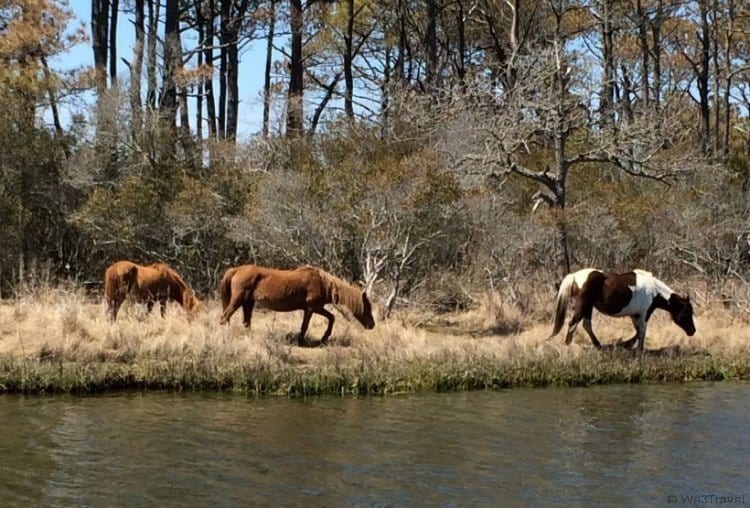
If you want to stick to the Mid-Atlantic coast, this road trip will bring you through cute Victorian towns, beautiful beaches, and nature preserves.
Cape May, NJ: start off your journey in Cape May. This quaint town isn’t like the rest of the Jersey Shore. Enjoy the gourmet restaurants, charming boutiques, and gingerbread-style Victorian homes.
Where to stay: Congress Hall
Lewes, DE: take the ferry across to Lewes, Delaware, another Victorian town full of history, cute cafes, and shops. You must stay a night so that you can take a sunset cruise past the lighthouse and if you get lucky, you may see some dolphins on the way.
Where to stay: Inn at Canal Square
Bethany Beach, DE: as you continue down to the beaches of Southern Delaware, you may also want to stop and check out some of the local breweries and wineries in this region. If you are seeking a boardwalk, combined with bike trails, and great restaurants, you may prefer Rehoboth Beach. Dewey Beach is full of seaside hotels and beach bars, along with gorgeous state beaches. But if you are seeking quiet for a few days at the beach, I would recommend Bethany Beach.
Where to stay: Bethany Beach Ocean Suites Residence Inn by Marriott
Chincoteague, VA: on your way to Assateague Island National Seashore to see the wild ponies, stop in the cute small town of Berlin, MD or for a stroll on the Ocean City boardwalk. To get up close to the wild horses, I would recommend taking a boat tour with Captain Dan from Chincoteague. Afterward, get some marsh mud ice cream at Island Creamery.
Where to stay: Hampton Inn and Suites Chincoteague Waterfront
Eastern Shore: Baltimore, MD to Virginia Beach, VA

Swing through Maryland and Virginia’s Eastern Shore on your way down to Virginia Beach. You can then take the highway back to Baltimore, with a stop in Norfolk or Williamsburg on your return trip.
Annapolis, MD: start off with a night in Annapolis. Spend the day exploring some of Annapolis’ historic sites, including the State House and the U.S. Naval Academy, as well as the boutiques and galleries downtown. Don’t leave town without enjoying some crab cakes!
Where to stay: Graduate Annapolis
St. Michaels, MD: spend a night enjoying the Chesapeake side of the Eastern Shore. The charming town of St. Michaels offers up plenty of retail therapy options, but also cultural attractions like the Chesapeake Bay Maritime Museum. Nearby you can go tasting at local wineries and breweries, or get out on the water with a kayak or paddle board.
Where to stay: St. Michaels Harbour Inn
Chincoteague, VA: the kids will then enjoy a night on the other side of the peninsula, finding the wild ponies at Chincoteague or exploring the Assateague National Seashore. Be sure to stop for ice cream at the Island Creamery!
Where to stay: Hampton Inn and Suites Chincoteague Waterfront
Virginia Beach, VA: there are so many things to do in Virginia Beach that you will want to spend a few days enjoying the wide sand beaches and exploring. Also, check out my friend Brianna’s guide to where to eat in Virginia Beach. If you want to take a day trip, pop over to Hampton to explore some early history or visit the Virginia Air and Space Museum.
Where to stay: Hilton Garden Inn Virginia Beach Oceanfront
Williamsburg, VA: finish your road trip in Colonial Williamsburg. Plan on a full day in Colonial Williamsburg, and if you have more time, include a visit to Historic Jamestowne and Yorktown, Busch Gardens, or Water Country USA.
Where to stay: Kingsmill Resort, Great Wolf Lodge Williamsburg
Skyline Drive: Washington DC to Charlottesville, VA

This road trip will bring you through Shenandoah National Park for a mix of outdoor adventures and historic landmarks. We covered this ground during part of a more extensive Virginia road trip a few years back.
Woodstock, VA: spend 2 nights in Woodstock, exploring nearby Shenandoah Caverns, climbing the Woodstock Tower, tubing on the Shenandoah River, enjoying summer sports at Bryce Resort, and hiking in Shenandoah National Park.
Where to stay: Hampton Inn & Suites Woodstock
Harrisonburg, VA: spend the day exploring Shenandoah National Park and driving the Skyline Drive before arriving in Harrisonburg for the night. This is a great road trip for a college tour because James Madison University is also located here. Be sure to also stop at Kline’s Dairy Bar for its famous custard-style ice cream.
Where to stay: Residence Inn Harrisonburg
Charlottesville, VA: plan on spending 2 nights in Charlottesville. Stroll and shop downtown and then enjoy a traditional, Colonial-style luncheon at the historic Michie Tavern, followed by a visit to Thomas Jefferson’s Monticello estate.
In the evening, head up to Carter Mountain Orchard to catch a sunset and some live music. On your second day, you can either explore more history at President James Monroe’s home, do some local wine tasting, tour the campus of the University of Virginia, or kayak along the James River.
Where to stay: Graduate Charlottesville
Richmond, VA: finish up your road trip with a couple of days in Richmond. While it was once the capital of the Confederate South, today the state capital is finding a new identity with plenty of street art, craft beer, and fun dining options. You may want to check out the Virginia Museum of Fine Arts, Lewis Ginter Botanical Garden, or the Institute of Contemporary Art before heading back to DC.
Where to stay: Graduate Richmond
Carolina Coast: Washington DC to Wilmington, NC
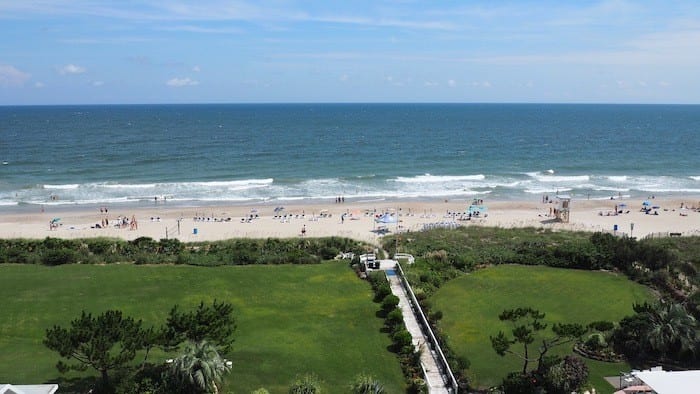
If you are ready to escape the city for the coast, it is time for a road trip down to Wilmington, North Carolina and Wrightsville Beach. The six-hour drive is long but then there is plenty to do on the Carolina coast once you arrive and this road trip gives you a chance to figure out your favorite beach.
Emerald Isle, NC: Emerald Isle is on North Carolina’s Crystal Coast, or the “southern” Outer Banks. This area attracts visitors who have returned for decades for the simple beach pleasures of a family vacation. Emerald Isle offers 12 miles of pristine shoreline and incredible views of the Atlantic Ocean and Bogue Inlet. Spend a few days enjoying watersports, fishing, or simply sitting on the sand and enjoying the sound of the waves rolling in.
Where to stay: Inn at Pine Knoll Shores, Islander Hotel & Resort
Surf City, NC: stay a couple of days in Surf City, the center of Topsail Island. The relaxing and uncrowded beaches are what some call “the way the beach used to be.” You can also enjoy kayaking, fishing, and boating on the Intercoastal.
Wrightsville Beach, NC: once you have arrived in Wrightsville Beach set up your home base for the next few days to explore. You will want to spend some time in the historic downtown of Wilmington, take a food tour in Kure Beach, stroll the grounds of Airlie Gardens, take a hike in Carolina State Park, or enjoy some beach time. Don’t miss a stop at Britt’s Donuts — the best on the east coast!
Where to stay: Blockade Runner Beach Resort
Low Country: Raleigh, NC to Savannah, GA

You can make the drive from Raleigh to Savannah in about five hours, but it pays to take the coastal route and make some stops along the way.
Myrtle Beach, SC: how long you spend in Myrtle Beach depends on the vibe of a beach town that you enjoy. If you enjoy a boardwalk, arcades, family attractions, and plenty of kitsch — then you will enjoy a classic family vacation to Myrtle Beach. But you can also get away from the crowds by kayaking through the salt marshes, strolling through Brookgreen Gardens, or paddle boarding.
Where to stay: Island Vista
Charleston, SC: for a complete change of pace, spend a night or two in the historic city of Charleston. Start off with a carriage tour through the downtown, visit some of the historic homes and gardens, and discover why Charleston is a foodie destination.
Where to stay: The Mills House Wyndham Grand
Beaufort, SC: spend a day exploring Beaufort, the upcoming-and-coming “next” Charleston or Savannah. Explore its antebellum mansions and downtown historic district. You can also enjoy the low country marshlands and waterways.
Where to stay: Anchorage 1770 Inn
Savannah, GA: finish up this east coast road trip in Savannah. Wander through the city’s many squares lined with oaks dripping in Spanish moss in Savannah’s historic district. Check out the Prohibition Museum, and then enjoy Savannah’s vibrant dining and craft cocktail scene. Stroll down touristy river street, take a ghost tour, visit some of the historic homes, or spend a day out on the beach at Tybee Island. See my friend Rob’s (who has an Airbnb there) favorite things to do in Savannah and my friend Karen has great suggestions on the best family restaurants in Savannah.
Where to stay: Perry Lane Hotel
Blue Ridge Mountains: Charlotte, NC to Gatlinburg, TN
If lakes and mountains are calling you, head towards the Blue Ridge Mountains and Great Smoky Mountains National Park — with a few stops along the way.
Lake Lure, NC: the backdrop to Dirty Dancing, Lake Lure is a favorite family vacation destination. You will need a couple of days to explore Lake Lure Flowering Bridge, Chimney Rock State Park, and Chimney Rock Village which has plenty of shops and dining options, along with a scenic riverwalk next to the creek that kids will enjoy playing in on a warm sunny day. Plus you have to leave time to enjoy the lake, by boat or beach.
Where to stay: Lake Lure Inn & Spa
Asheville, NC: located on the Blue Ridge Parkway, Asheville has many fun things to do with kids. Take the Blue Ridge Highway to Sliding Rock, Looking Glass Falls, and other hiking trails. Swing from the treetops at the Adventure Center of Asheville, play some games at the Asheville Pinball Museum, visit the Biltmore Estate, one of the most popular things to do in North Carolina, or sample some local craft brews.
Where to stay: Aloft Asheville Downtown
Gatlinburg, NC: use Gatlinburg as your base for exploring parts of Great Smoky Mountains National Park (don’t miss Cades Cove Loop) and Pigeon Forge as well. You can go hiking, bike through the park, spend a day at Dollywood, go zip lining, see the view from Clingmans Dome, go horseback riding, or see a show.
Where to stay: Margaritaville Resort Gatlinburg
Coastal Islands: Wilmington, NC to Jacksonville, FL
Another coastal road trip, this one bypasses the cities in favor of luxury beach destinations and brings you from Wilmington, NC all the way down to Jacksonville, Florida. A 6.5-hour drive by highway, you can spend a week or more exploring the coast. This trip brings you to some of the best beaches in the USA.
Kiawah Island: start off your road trip in luxury at the Kiawah Resort. This private residential island and resort is famous for its acclaimed golf course, but families can also enjoy 5-Star accommodations and 10 miles of private sandy shoreline.
Where to stay: The Sanctuary Hotel at Kiawah Island Resort
Hilton Head Island: spend a couple of days enjoying the beaches of Hilton Head Island. You can also golf, take a guided dolphin or kayak tour, or enjoy some low-country cuisine. You won’t find tacky souvenir shops or neon signs. HHI has a quieter, more relaxed way of life.
Where to stay: Disney’s Hilton Head Island Resort
Amelia Island: finish this luxe road trip at The Ritz-Carlton, Amelia Island. Relax and enjoy the resort, search for shark teeth, star gaze from the beach, go shopping in downtown Fernandina Beach, take a kayaking tour, or hop a ferry for a day trip to Cumberland Island to see the wild horses.
Where to stay: The Ritz-Carlton, Amelia Island
Civil Rights Trail: Atlanta, GA to Memphis, TN
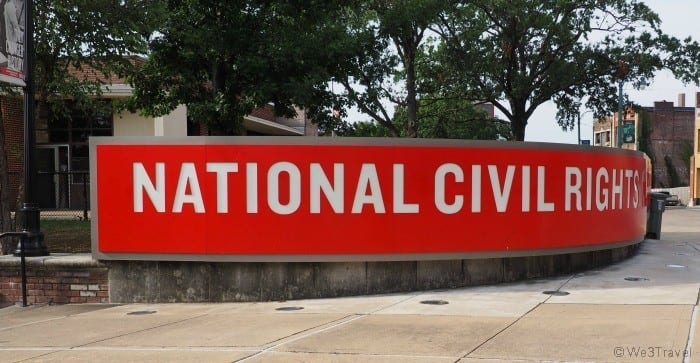
It is a six-hour drive from Atlanta to Memphis, and I recommend turning it into a Civil Rights road trip.
Atlanta: starting off in Atlanta, if you haven’t already visited I would recommend spending a couple of days visiting some of the important Civil Rights sites including the Center for Civil and Human Rights and the Dr. Martin Luther King Jr. National Historic Site. Another fun way of exploring some history is through a food tour with Atlanta Food Walks.
Where to stay: Loews Atlanta Hotel
Montgomery, AL: plan on spending a full day in Montgomery visiting the Rosa Parks Museum, the Freedom Rides Museum, and the National Memorial for Peace and Justice, which honors victims of lynchings. On your way to Birmingham, you can make a detour to Selma to walk across the Edmund Pettus Bridge and visit other Civil Rights sites.
Where to stay: Renaissance Montgomery Hotel & Spa
Birmingham, AL: if you stop in Selma, you may want to plan on spending 2 nights in Birmingham so you don’t have to rush. Be sure to visit the Birmingham Civil Rights Institute, Kelly Ingram Park, and the Sixteenth Street Baptist Church. Take some time to enjoy Birmingham’s up-and-coming neighborhoods and food scene too.
Where to stay: Westin Birmingham
Memphis, TN: it is easy to spend at least 3 days in Memphis, more if you want to do a day trip to Graceland. You will need a half-day to take in the sobering exhibits at the National Civil Rights Museum at the Lorraine Motel (the place where MLK Jr. was assassinated.) Also visit Slave Haven, Sun Studios and STAX Museum of American Soul Museum. Just leave time to enjoy some great BBQ and soul food.
Where to stay: The Peabody Memphis
Read more: Plan a civil rights road trip
Golden Isles: Savannah, GA to St. Augustine, FL

This coastal road trip from Savannah to St. Augustine, Florida stops at many of Georgia’s Islands along the way.
Little St. Simons Island: spend a few days on this private island nature preserve with just 32 other guests and 7 miles of pristine beach to explore. Take advantage of twice-daily naturalist-led expeditions, kayak through the marshes to go bird watching, bike to the beach, or track some of the property’s resident armadillos.
Where to stay: Little St. Simons Resort
Jekyll Island: plan on spending at least 2-3 days on Jekyll Island, another of Georgia’s Golden Isles. You will want to visit Driftwood Beach, check out the Georgia Sea Turtle Center, picnic at South Dunes Beach Park, relax on one of the many Jekyll Island beaches or even enjoy a day at the waterpark.
Where to stay: Jekyll Island Club Resort
St. Augustine, FL: finish your road trip with a visit to historic St. Augustine — the country’s oldest continuously occupied city. You can stay on the beach or in town but be sure to check out both. You can visit the Fountain of Youth, walk the ramparts at Castillo St. Marcos, take a trolley tour, take a food tour to discover some of the town’s best places to eat, take a ghost tour, climb a lighthouse, or explore these other fun things to do with kids.
Where to stay: Embassy Suites St. Augustine Beach
Florida Coast: St. Augustine to Miami, FL
Driving the east coast of Florida from Jacksonville to Miami can be done in five hours, but why miss all the great beaches, history, and fun attractions on the way?
Jacksonville / St. Augustine: you can fly into Jacksonville or start off in St. Augustine. In addition to all the historic town of St. Augustine has to offer (see above), Jacksonville offers plenty for kids too with the Jacksonville Zoo and Gardens, Museum of Science and History, Sweet Pete’s Candy Shop, TopGolf, and more.
Where to stay: The Lodge & Club at Ponte Vedra Beach
Cocoa Beach, FL: spend 2 to 3 days enjoying the area near Cocoa Beach, including a full day at Kennedy Space Center. You can also kayak past the giraffes at nearby Brevard Zoo in nearby Melbourne or learn to surf at Cocoa Beach, the East Coast surf capital.
Where to stay: Hampton Inn Cocoa Beach
Hollywood, FL: next you can stay a couple of nights in Hollywood, between Fort Lauderdale and Miami. Enjoy strolling along the Hollywood Beach Boardwalk, ArtsPark at Young Circle, the Art and Culture Center of Hollywood, and the Anne Kolb Nature Center, with mangrove trails and an aquarium.
Where to stay: Margaritaville Hollywood Beach Resort
Miami, FL: if you have had enough beach time, you can focus on Miami’s neighborhoods and cultural attractions including Wynwood Walls, Little Haiti, Little Havana, and the Vizcaya Museum and Gardens. Even plan a day trip to the Everglades for an alligator airboat tour! Of course, you can’t leave town without at least checking out Miami Beach.
Where to stay: Eden Roc Beach Hotel or The Diplomat Beach Resort
Florida Keys: Miami to Key West, FL
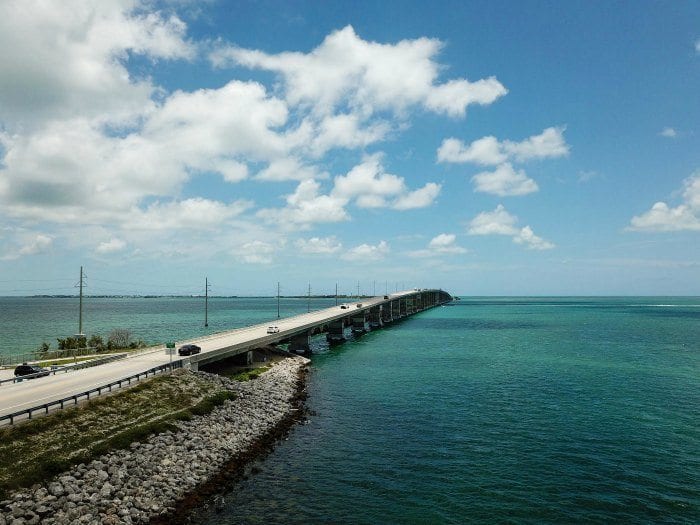
Driving from Miami to Key West is a classic American road trip. The trip can take a good five hours, but you need to leave plenty of time depending on traffic. It gives you the time to get into “island mode.”
Key Largo: it is best to break up the trip by staying a few days in the upper keys, since every key has its own personality. From here you can explore most of what Key Largo and Islamorada have to offer including John Pennekamp Coral Reef State Park, snorkeling or other watersports at Robbie’s, or glass-bottom boat tours of the Key Largo National Marine Sanctuary.
Where to stay: Baker’s Cay Resort
Duck Key: Hawk’s Cay at Duck Key is a great spot for families to stop and relax for a few days, enjoying all the activities on this family-friendly resort.
Where to stay: Hawks Cay Resort
Key West: on your way to Key West, you will want to stop at the Turtle Hospital in Marathon and Bahia Honda State Park. Once in town, don’t miss out on the famous Sunset Celebration. You may also want to take a snorkel cruise or sunset catamaran. You can explore Key West’s vibrant food scene with a food tour — plus find out where to get the best Key Lime pie. Don’t forget to take a picture at the Southernmost Point.
Where to stay: Margaritaville Key West
Read more: Plan a Florida Keys road trip
Southwest Florida: Miami to Tampa, FL
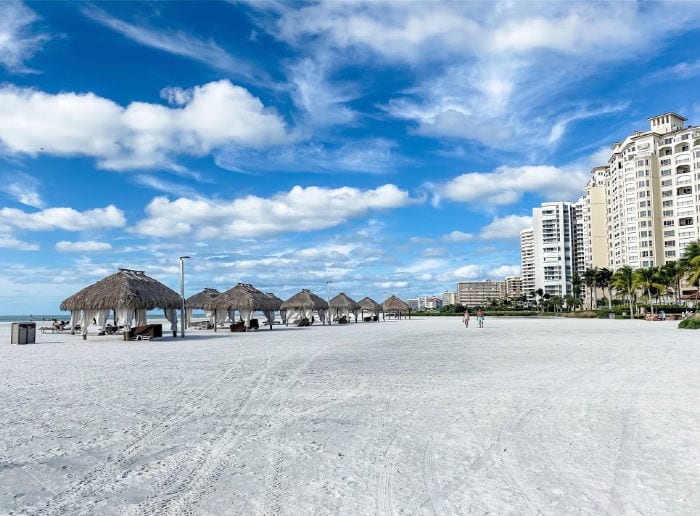
Cross Alligator Alley from Miami to Southwest Florida to explore the beauty of the Paradise Coast. Each town has its own personality so you will want to do a little beach hopping on your way up Florida’s Gulf Coast.
Marco Island: the wide, white sand beaches of Marco Island will entice you to stay for a few days. On the way, you should stop at Everglades National Park and take one of the many airboat tours available. You may also enjoy a dolphin watch tour, kayaking, paddle boarding, fishing, parasailing, and even jet skiing. A nature walk in Big Cypress Nature Preserve will introduce you to the area’s plant and wildlife.
Where to stay: JW Marriott Marco Island Beach Resort
Captiva Island: shelling fans will find their paradise on Sanibel and Captiva Islands. With much of the islands kept as a nature preserve, you are bound to spot dolphins, manatees, and abundant birdlife.
Where to stay: Seven Seas Island Resort
Clearwater Beach: just west of Tampa, the sugar-soft white sand of Clearwater has long been recognized as one of the best beaches in the U.S. In addition to beach time and water sports, families enjoy visiting the Clearwater Marine Aquarium. You can also explore the cultural attractions and family attractions of Tampa, including Busch Gardens, ZooTampa, the Museum of Science and Industry, and more.
Where to stay: Hyatt Regency Clearwater
Central Florida: Daytona to Clearwater, FL
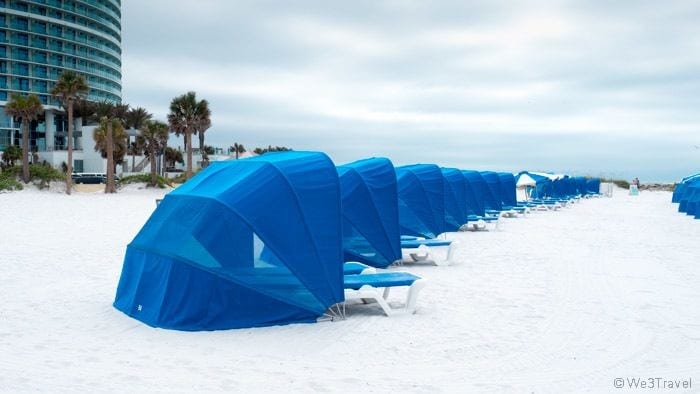
The shortest road trip may be across Florida from Daytona Beach to Clearwater. Yet there is so much to do in Orlando and Central Florida that you can easily spend a week or more getting the best of all worlds from the beach to the theme park.
Orlando: before leaving Daytona Beach, make sure you spend a day at the Kennedy Space Center, especially if you are lucky enough to be around to launch day. Of course in Orlando you can spend weeks in Disney, Universal, Legoland, and SeaWorld, plus all the water parks like Volcano Bay and Margaritaville’s H2O. But there are so many off-the-beaten-path Orlando attractions too from kayaking through the wetlands to visiting nearby natural springs.
Where to stay: Margaritaville Orlando
Clearwater Beach: before arriving in Clearwater Beach, you may want to hit up some of the attractions in Tampa, like Busch Gardens or ZooTampa. Then take time to relax on the sugar-soft white sand beaches of Clearwater. Take a pirate cruise, enjoy movies in the park, and visit Winter the Dolphin (famous from the movie A Dolphin’s Tale) and the Clearwater Marine Aquarium.
Where to stay: Wyndham Grand Clearwater Beach
Panhandle: Orlando, FL to Orange Beach, AL
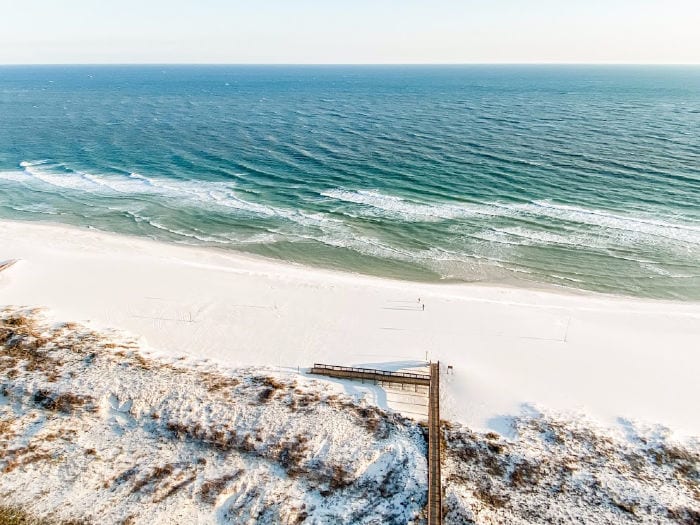
When you are ready to escape Central Florida for the gorgeous beaches of the Panhandle, head north on this Florida road trip.
Tallahassee: the drive from Orlando to Tallahassee takes about 4 hours, but there are plenty of natural springs, like Crystal River or Rainbow Springs, to stop at along the way. Or, turn it into a college trip and visit the University of Florida in Gainesville. In Tallahassee, you will find trees lined with trees dripping in moss instead of the palm trees of South Florida. Kids will also enjoy the Tallahassee Museum, Challenger Learning Center, Mission San Luis, and the Gulf Specimen Marine Lab.
Where to stay: aLoft Tallahassee Downtown
Destin: get ready for a few days of beach life in Destin on the Panhandle’s Emerald Coast. There are a ton of things to do with kids including the Gulfarium Marine Adventure Park, Indian Mound Museum, Big Kahuna’s water park, banana boat rides, parasailing, and more.
Where to stay: Hilton Sandestin Beach Golf Resort
Orange Beach, AL: one of our favorite beaches, you can compare the Florida versus Alabama Gulf coast experience. In addition to relaxing on the sugar-soft sands of Gulf Shores or Orange Beach, there is so much else to do from biking in Gulf State Park, zip lining at The Wharf, sunset cruises with Sail Wildhearts, dolphin cruises, and of course, chowing down on amazing food!
Where to stay: Turquoise Place
Time to grab your road trip essentials and hit the road! If you don’t find what you are looking for, you can also take a New York to Florida road trip.
I hope this East Coast road trip planner was helpful. If you still need more inspiration, see more East Coast vacation ideas or things to do in New England.
Save this on Pinterest
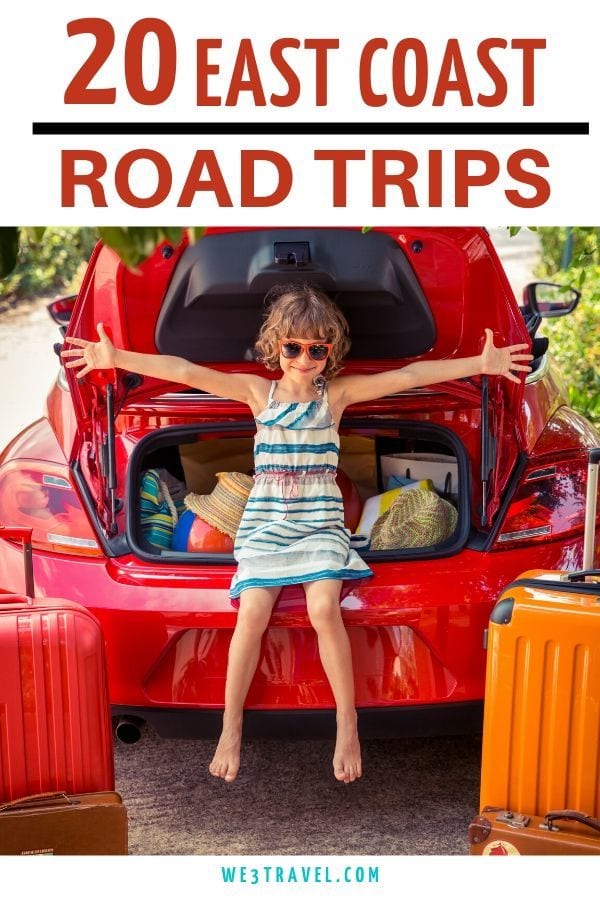

Tamara Gruber is the Founder and Publisher of We3Travel. A former marketing executive and travel advisor, Tamara is an award-winning travel writer and recognized expert in family travel. Tamara is a member of SATW, NATJA, IFWTWA, and the Adventure Travel Trade Association, and serves on the Board of the Family Travel Association. She is also the publisher of YourTimetoFly.com and the co-host of the Vacation Mavens travel podcast.



Comments are closed.